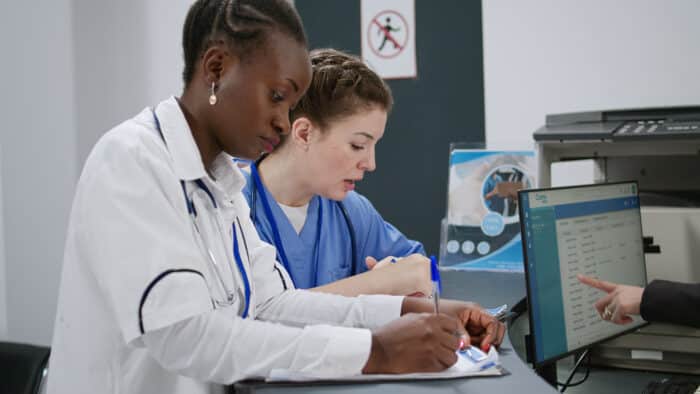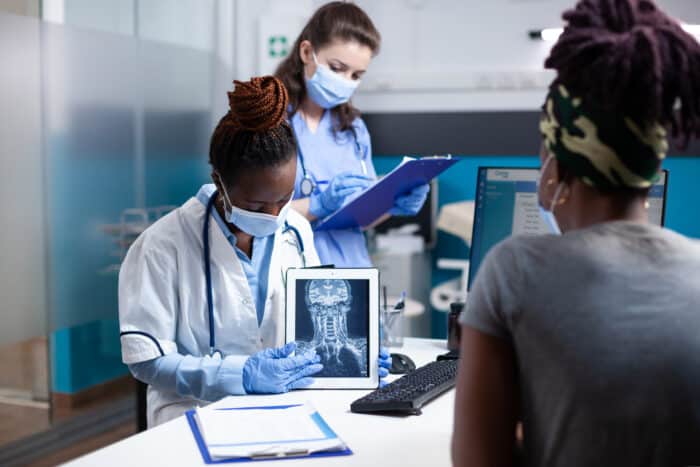If you’re passionate about starting a career in healthcare administration and paying attention to details, being a medical billing and coding pro might be perfect for you.
Ever wanted to be a hero behind the scenes in healthcare?
Medical billers and coders are like secret heroes in healthcare. They make sure all the medical records are sorted and billed correctly, which helps keep patients safe and everything running smoothly.
In this article, we’re going to talk about what it’s like to be a medical billing and coding pro. We’ll cover how to get started, what skills you’ll need, and how much time it takes.
Whether you’re new to this or thinking about a change, we’ve got all the info you need.
Let’s go!
Medical Biller and Coder: Career Overview
Alright, let’s start with the basics and delve into who exactly medical billers and coders are and what they do.
Medical billers and coders, also referred to as healthcare coding specialists or medical reimbursement specialists, are important figures in the healthcare sector.
Their primary responsibility revolves around accurately translating medical procedures, diagnoses, and treatments into universal codes used for billing and insurance purposes.
Their tasks typically include:
1. Coding: They assign specific codes to various medical procedures, diagnoses, and treatments, ensuring accurate documentation for billing purposes.
2. Billing: They use these codes to generate invoices and submit claims to insurance companies and other payers to ensure healthcare providers receive proper reimbursement for their services.
3. Record Keeping: They maintain detailed records of patient treatments, billing information, and insurance claims, ensuring compliance with regulatory standards and facilitating communication between healthcare providers and payers.
4. Communication: They often liaise between healthcare providers, insurance companies, and patients to clarify billing inquiries, resolve discrepancies, and ensure accurate reimbursement.
Choosing the Right Training Program & Why It is Important
So, the first big step in getting started with your career in medical billing and coding is finding the right training program.
Choosing the perfect program is key for anyone aspiring to become a medical biller or coder because it sets you up for success in the healthcare world.
A top-notch program will give you all the knowledge and hands-on experience you need to thrive in this field.
And don’t forget about practical training opportunities—they’re super important for mastering tasks like coding medical procedures and making sure everything’s billed accurately.
What Are the Types of Medical Billing and Coding Training Programs Available?
As you step into the world of medical billing and coding, as we discussed just above, finding the right training program is essential.
But what types of training programs are available for medical billing and coding? Let’s explore your options:
Associate Degree Programs:
These programs typically last around 2 years and are offered by community colleges or technical institutes.
While they require a significant time commitment, they provide in-depth education on medical billing and coding, healthcare regulations, and advanced skills. You’ll cover a wide range of topics, from medical terminology to coding systems.
Also, earning an associate degree can enhance your credibility and open up more career opportunities within the healthcare industry.
Certificate/Diploma Programs:
These programs are shorter in duration, usually lasting about a year, and can be found at vocational schools or community colleges.
They offer a focused curriculum that covers both theory and hands-on skills specific to medical billing and coding.
You’ll learn how to use coding systems effectively, navigate healthcare regulations, and handle various billing processes. While they may not offer as much depth as associate degree programs, they provide practical training that prepares you for entry-level positions in the field.
Online Sterile Processing Programs:
Online programs offer the flexibility to study from anywhere, making them ideal for individuals with busy schedules or those who prefer self-paced learning.
These programs typically last between 4 to 6 months and are more affordable compared to traditional on-campus programs.
However, it’s essential to ensure that the online program you choose is accredited and includes hands-on training components. Look for programs that offer interactive simulations or virtual labs to practice coding and billing tasks.
While online programs may lack the face-to-face interaction of traditional programs, they provide a convenient option for gaining the necessary skills to start a career in medical billing and coding.
How to Become a Medical Coder and Biller?
If you’re still with us and considering a career in medical billing and coding, let’s guide you through the steps required to become one:
Step 1: High School Diploma or GED
Obtaining a high school diploma or GED (General Educational Development) certificate is the minimum requirement for pursuing a career in medical billing and coding.
It demonstrates basic educational attainment and sets the stage for further training and development in the field.
Step 2: Enroll in a Medical Billing and Coding Training Program
Selecting the right training program is important for gaining the necessary knowledge and skills in medical billing and coding.
Look for accredited programs that offer comprehensive coursework covering medical terminology, coding systems (CPT, ICD, HCPCS), insurance billing procedures, and legal and ethical considerations.
These programs may be offered by community colleges, vocational schools, or online institutions. Hands-on training components, such as coding exercises or practical experience in medical office settings, can enhance learning and prepare you for the demands of the job.
Step 3: Gain Practical Experience
While theoretical knowledge is important, practical experience is invaluable in the medical billing and coding field.
Seek opportunities for internships, externships, or volunteer positions in healthcare settings to apply your skills in a real-world context. Practical experience allows you to become familiar with electronic health records (EHR) systems, coding software, and the day-to-day responsibilities of a medical biller and coder.
Step 4: Certification (Recommended)
Although certification is not always mandatory, obtaining professional certification can greatly enhance your credibility and employability as a medical biller and coder.
Certification demonstrates your mastery of coding systems and adherence to industry standards, making you a more competitive candidate in the job market.
The two primary certifying bodies for medical billers and coders are the American Academy of Professional Coders (AAPC) and the American Health Information Management Association (AHIMA).
Consider pursuing certifications such as Certified Professional Coder (CPC) or Certified Coding Specialist (CCS) to validate your expertise and commitment to excellence in the field.
Step 5: Apply for Medical Billing and Coding Jobs
With your education, training, and certification in hand, you’re ready to start on your career journey as a medical biller and coder.
Begin by researching job opportunities in hospitals, physician offices, outpatient clinics, insurance companies, or medical billing companies.
Types of Medical Billing and Coding Certifications
If you’re considering becoming a certified sterile processing technician, you might find yourself faced with multiple certification options, which can be quite confusing.
But don’t worry, we’re here to help simplify things for you!
Let’s take a look at some of the most common and highly recommended certifications available for aspiring sterile processing technicians:
Certified Professional Coder (CPC) by AAPC:
– Cost: The exam fee ranges from $300 to $400 for AAPC members and $425 to $525 for non-members.
– Renewal Fee: Renewal typically costs around $160 to $200 every two years.
– Requirements: Candidates must pass the CPC exam, which covers medical coding guidelines and regulations.
Certified Coding Specialist (CCS) by AHIMA:
– Cost: The exam fee ranges from $299 to $399 for AHIMA members and $399 to $499 for non-members.
– Renewal Fee: Renewal typically costs around $160 to $200 every two years.
– Requirements: Candidates must pass the CCS exam, demonstrating proficiency in inpatient and outpatient medical coding.
Certified Professional Biller (CPB) by AAPC:
– Cost: The exam fee ranges from $300 to $400 for AAPC members and $425 to $525 for non-members.
– Renewal Fee: Renewal typically costs around $160 to $200 every two years.
– Requirements: Candidates must pass the CPB exam, which covers medical billing principles and practices.
Certified Outpatient Coder (COC) by AAPC:
– Cost: The exam fee ranges from $300 to $400 for AAPC members and $425 to $525 for non-members.
– Renewal Fee: Renewal typically costs around $160 to $200 every two years.
– Requirements: Candidates must pass the COC exam, which focuses on outpatient coding and reimbursement.
Skills Required to Become a Medical Biller and Coder
Now that you know everything about medical billing and coding as a career, you might be curious about the skills it takes to become a successful one.
Becoming a medical biller and coder requires a blend of technical skills, attention to detail, and a commitment to safety and quality.
Here are some key skills needed:
1. Attention to Detail: You’ve got to be as sharp when it comes to catching every detail in medical records. One missed code or incorrect entry could throw off the whole billing process.
2. Analytical Skills: It’s like solving a puzzle every day. You’ll need to analyze medical records, decipher doctors’ notes, and figure out the right codes to accurately document everything.
3. Organizational Skills: Think of yourself as the master organizer of medical information. You’ll be juggling a ton of patient records, billing documents, and insurance forms, so staying organized is key.
4. Technical Proficiency: You’ll be using specialized software and electronic health record systems, so being comfortable with technology is a must.
5. Medical Terminology Knowledge: From “ablation” to “zygote,” you’ll need to speak the language of medicine fluently. Knowing your anatomy and medical terms inside out will help you assign the right codes with confidence.
6. Coding Proficiency: It’s like learning a new language but with numbers and symbols instead of words. You’ll need to be a coding whiz with systems like CPT, ICD, and HCPCS to accurately document procedures and diagnoses.
7. Ethical Standards: Your integrity is non-negotiable. Upholding patient confidentiality and ethical standards is a must to maintain trust in the healthcare system.
8. Communication Skills: You’ll be the liaison between healthcare providers, insurance companies, and patients, so clear and effective communication is key. Whether you’re resolving billing disputes or clarifying medical codes, strong communication skills will be your secret weapon.
Conclusion
When it comes to embarking on a career as a medical biller and coder, the timeline can vary depending on the program you select. However, rest assured, the journey is undoubtedly worthwhile.
Whether it’s completing the necessary training or acquiring practical experience, the process may span from a few months to a couple of years.
Related Resources:
Related Articles
-
How to Be Successful in College in 2022 – 7 Simple Tips to Succeed
-
How Do Scholarships Work? Read This First…Truth is Shocking
-
7 Best College Majors 2024: What Should I Major In?
-
How to Choose a College – 10 Things You Must Consider in 2024
-
Why Go to College? Top 13 Benefits for Adult Students in 2022
-
Top 5 Best Alternatives to Community College for 2024










